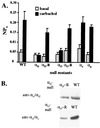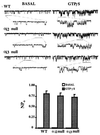Targeted inactivation of alphai2 or alphai3 disrupts activation of the cardiac muscarinic K+ channel, IK+Ach, in intact cells
- PMID: 9223288
- PMCID: PMC21530
- DOI: 10.1073/pnas.94.15.7921
Targeted inactivation of alphai2 or alphai3 disrupts activation of the cardiac muscarinic K+ channel, IK+Ach, in intact cells
Abstract
Cardiac muscarinic receptors activate an inwardly rectifying K+ channel, IK+Ach, via pertussis toxin (PT)-sensitive heterotrimeric G proteins (in heart Gi2, Gi3, or Go). We have used embryonic stem cell (ES cell)-derived cardiocytes with targeted inactivations of specific PT-sensitive alpha subunits to determine which G proteins are required for receptor-mediated regulation of IK+Ach in intact cells. The muscarinic agonist carbachol increased IK+Ach activity in ES cell-derived cardiocytes from wild-type cells, in cells lacking alphao, and in cells lacking the PT-insensitive G protein alphaq. In cells with targeted inactivation of alphai2 or alphai3, channel activation by both carbachol and adenosine was blocked. Carbachol-induced channel activation was restored in the alphai2- and alphai3-null cells by reexpressing the previously targeted gene and guanosine 5'-[gamma-thio] triphosphate was able to fully activate IK+Ach in excised membranes patches from these mutants. In contrast, negative chronotropic responses to both carbachol and adenosine were preserved in cells lacking alphai2 or alphai3. Our results show that expression of two specific PT-sensitive alpha subunits (alphai2 and alphai3 but not alphao) is required for normal agonist-dependent activation of IK+Ach and suggest that both alphai2- and alphai3-containing heterotrimeric G proteins may be involved in the signaling process. Also the generation of negative chronotropic responses to muscarinic or adenosine receptor agonists do not require activation of IK+Ach or the expression of alphai2 or alphai3.
Figures








References
-
- Clapham D E. Annu Rev Neurosci. 1994;17:441–464. - PubMed
-
- Kurachi Y. Am J Physiol. 1995;269:C821–C830. - PubMed
-
- Migeon J C, Thomas S L, Nathanson N M. J Biol Chem. 1995;270:16070–16074. - PubMed
-
- Krapivinsky G, Gordon E A, Wickman K, Velimirovic B, Krapivinsky L, Clapham D E. Nature (London) 1995;374:135–141. - PubMed
-
- Wickman K D, Iniguez-Lluhl J A, Davenport P A, Taussig R, Krapivinsky G B, Linder M E, Gilman A G, Clapham D E. Nature (London) 1994;368:255–257. - PubMed
Publication types
MeSH terms
Substances
Grants and funding
LinkOut - more resources
Full Text Sources
Other Literature Sources
Molecular Biology Databases

